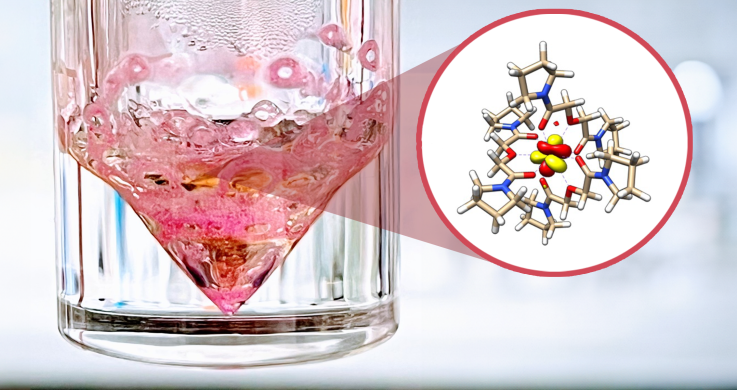Reviewed by Lexie CornerJun 10 2024
A group of researchers from Oak Ridge National Laboratory (ORNL) and the National Institute of Standards and Technology used a combination of experimentation and computer simulation to purify the promethium radionuclide and synthesize a coordination complex that was characterized for the first time. The study has been published in the journal Nature.
 ORNL scientists have discovered hidden features of promethium, opening a pathway for research into other lanthanide elements. Image Credit: Thomas Dyke, Dmytro Bykov, ORNL/US Dept. of Energy
ORNL scientists have discovered hidden features of promethium, opening a pathway for research into other lanthanide elements. Image Credit: Thomas Dyke, Dmytro Bykov, ORNL/US Dept. of Energy
The lanthanide series of chemical elements was completed in 1945 with the isolation of element 61, also referred to as promethium, by researchers at the Department of Energy's Oak Ridge National Laboratory.
Among the 15 lanthanides, or rare earth elements, is promethium. Even though they are referred to as “rare,” many of these elements are widely utilized in modern technology, such as computer monitors, smartphones, radiation therapy, and spacecraft batteries.
Even though scientists have been aware of it for almost 80 years, promethium was the only lanthanide not characterized in the bound form, which is necessary for determining an element's electronic structure and properties. This was due to radioactive promethium's short half-life (that is, the amount of time it takes one-half of the nuclei in a given amount of a radioactive element to decay) of only 2 ½ years. This makes it particularly elusive in nature.
This is fundamental research. Since the discovery of the periodic law, we have had a good understanding of all the elements, but that doesn’t change the fact that you need to experiment to confirm that understanding. It was nice to find this final puzzle piece.
Dmytro Bykov, Theoretical Chemist and Group Leader, Advanced Computing for Chemistry and Materials, Oak Ridge National Laboratory
Bykov co-led the computational spectroscopy simulation of the promethium complex with Santanu Roy, also from ORNL.
Promethium was investigated by creating a new water-soluble complexing agent and determining its electronic structure using X-Ray absorption spectroscopy. Experimentation was combined with theoretical and computational chemistry to paint a more complete picture of promethium.
The team used the IBM AC922 supercomputer Summit at ORNL's Oak Ridge Leadership Computing Facility to model the element. They were given time on the supercomputer through the Director's Discretionary Program. The OLCF is a Department of Energy Office of Science user facility.
This is experimental science, so the most important thing is that the team purified and characterized the element in the bound form. But the cherry on top is that we were able to run these simulations for a deeper understanding of the experimental observations.
Dmytro Bykov, Theoretical Chemist and Group Leader, Advanced Computing for Chemistry and Materials, Oak Ridge National Laboratory
Prometethium's electronic structure was difficult to simulate and involved solving intricate equations to represent the element's electrons. Most textbooks present an oversimplified depiction of atomic structure, with a nucleus made up of protons and neutrons orbiting fixed electron paths. In actuality, electrons are quantum objects with behavior more akin to waves, and the probability of their precise location at any given time determines it. The Schrödinger equation had to be solved to simulate the structure of promethium.
Solving the equation describes the wavefunctions and energies of electrons in an atom or molecule like a simple wave equation describes the vibration of a plucked guitar string. Scientists then use this information and observations from spectroscopy to represent the atom or molecule in 3D. The simulations of the element build are a more thorough picture than that could be produced with an experiment alone.
Most of the time, in an experiment, you can’t measure everything. You have a specific set of conditions, and the experiment is a snapshot. In the computer, we can change the conditions and get a deeper understanding of the element’s properties.
Dmytro Bykov, Theoretical Chemist and Group Leader, Advanced Computing for Chemistry and Materials, Oak Ridge National Laboratory
Bykov continued, “We all stand on the shoulders of giants. A lot of knowledge we had already, and there was so much work done at this lab. Summit, this marvelous machine, was built by very smart engineers and technicians. And it all came together to characterize and fully understand this remarkable compound of this very rare element for the first time.”
Lead authors on this project were Ilja Popovs, Alex Ivanov, and Santa Jansone-Popova of ORNL's Chemical Sciences Division. Co-authors included Darren M. Driscoll, Subhamay Pramanik, Jeffrey Einkauf, and Santanu Roy from ORNL's Chemical Sciences Division; other authors included Frankie White, Richard Mayes, Laetitia Delmau, Samantha Cary, Thomas Dyke, April Miller, Matt Silveira, Shelley VanCleve, and Sandra Davern from ORNL's Radioisotope Science and Technology Division; Bruce Ravel from the National Institute of Standards and Technology; and Dmytro Bykov from ORNL's National Center for Computational Sciences.
The team also utilized the National Synchrotron Light Source II at Brookhaven National Laboratory, ORNL's High Flux Isotope Reactor, and Radiochemical Engineering Development Center, in addition to the OLCF.
Journal Reference:
Driscoll, M. D., et al. (2024) Observation of a promethium complex in solution. Nature. doi.org/10.1038/s41586-024-07267-6